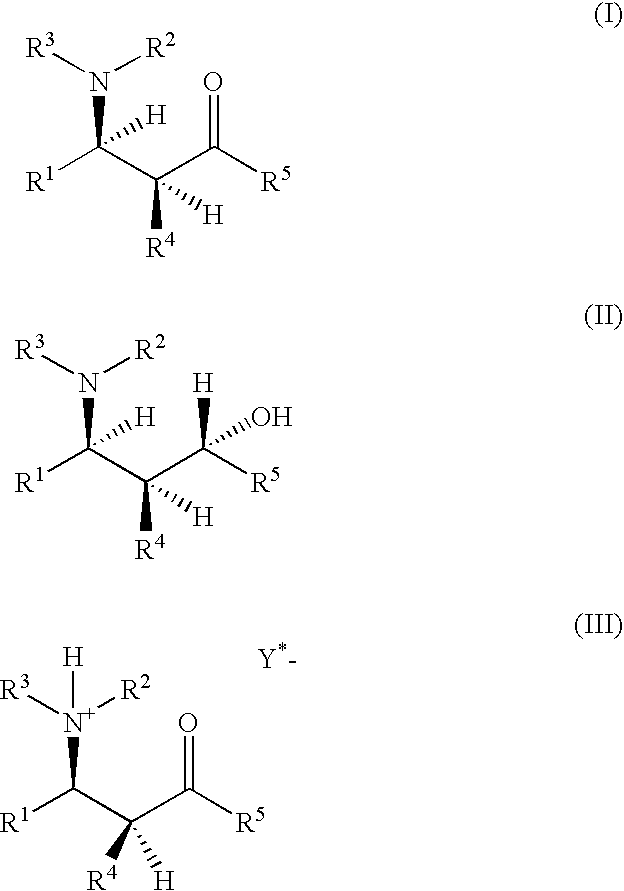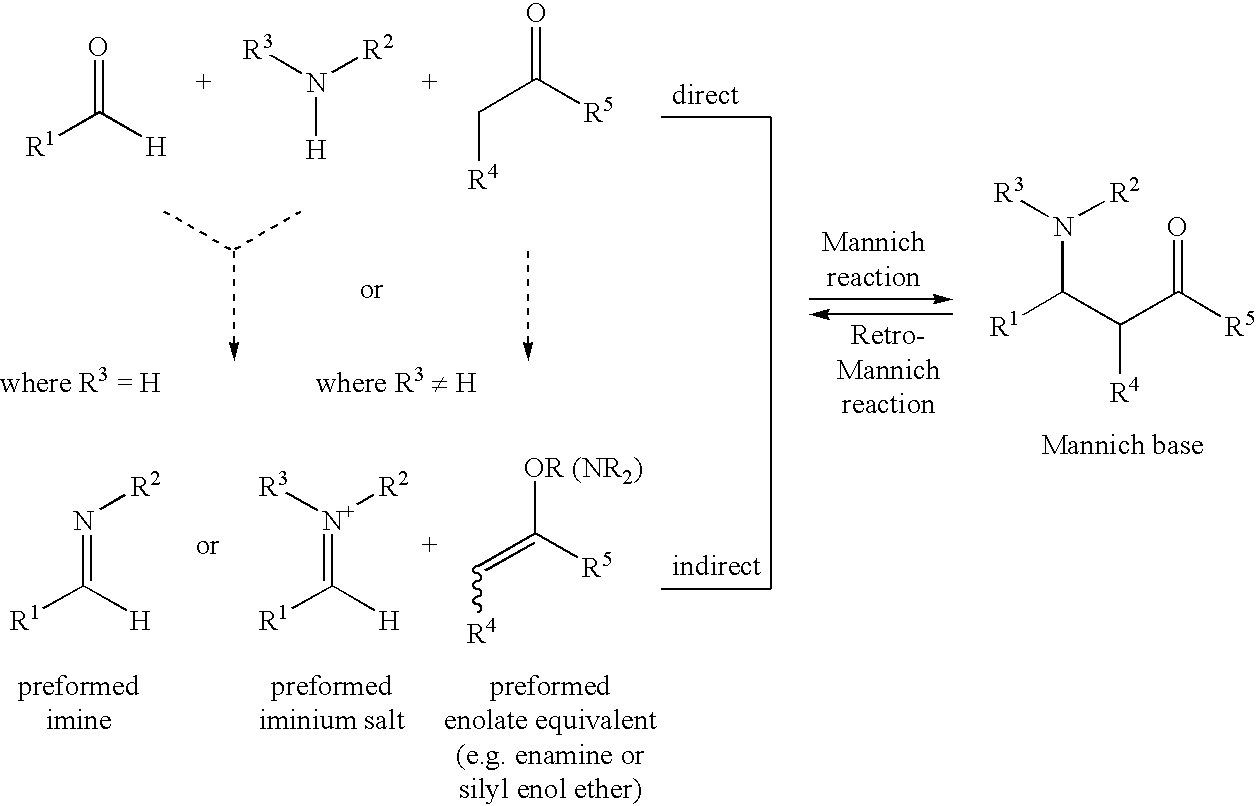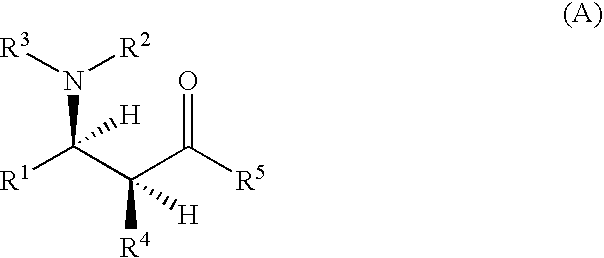Optically active β-aminoketones, optically active 1,3-amino alcohols and processes for preparing them
a technology of -aminoketones and -amino alcohols, which is applied in the field of optically active -aminoketones and optically active 1, 3amino alcohols, can solve the problems of poor storage, acid and hydrolysis resistance, and less industrially attractive indirect variants of the mannich reaction, and achieves high diastereomeric purity, high yield, and high enantiomeric excess
- Summary
- Abstract
- Description
- Claims
- Application Information
AI Technical Summary
Benefits of technology
Problems solved by technology
Method used
Image
Examples
example 1
[0283]Determination of the enantiomeric excess of Mannich bases of the general formula (I) or of Mannich salts of the general formula (III) wherein R1 is o-nitrophenyl, R2 is 2-pyridyl, R3 is H, R4 is 2-pyridyl, R5 is phenyl and HY* is (S)-(+)-mandelic acid, by derivatizing with (−)-camphanoyl chloride.
[0284]10 mg of the Mannich base (I) specified in the title or its salt (III) are weighed into a 10 mL volumetric flask and admixed with 200 mg of (−)-camphanoyl chloride. 1 mL of triethylamine is added and the mixture is made up to exactly 10 mL using approx. 9 mL of acetonitrile (HPLC grade). The mixture is dissolved within 30 seconds in an ultrasound bath. 1 mL of the initially light yellow solution is transferred to an HPLC vial and, after a 10 min delay time, 8.0 μL thereof are injected to a Machery-Nagel CC 250 mm×4 mm Nucleosil 100-5 C18 / 5 μm HD HPLC column. The elution is effected at a flow rate of 1.00 mL / min with a linear gradient composed of the two following eluents:[0285]E...
example 2
[0296]Determination of the enantiomeric excess of Mannich bases of the general formula (I) or of Mannich salts of the general formula (III) wherein R1 is o-nitrophenyl, R2 is 2-pyridyl, R3 is H, R4 is 2-pyridyl, R5 is phenyl and HY* is (S)-(+)-mandelic acid, by derivatizing with pivaloyl chloride.
[0297]In a 2 mL HPLC vial, 1 mg of the Mannich base (I) specified in the title or its salt (III) is dissolved in 20 μL of pivaloyl chloride, 100 μL of triethylamine and 500 μL of acetonitrile (HPLC grade). After exactly 5 minutes, the reaction is stopped by adding 500 μL of water. The vial is immediately sealed with the septum cap, placed in the autosampler of the HPLC instrument and, after a 10 min delay time, 5 μL thereof are injected onto a Merck Darmstadt 250 mm×4 mm 5 μm CHIRADEX column (β-Cyclodextrin) (Order No. 1.51333.0001, Cartridge No. 971324). The elution is effected isocratically at a flow rate of 1.00 mL / min using the following eluent mixture:[0298]Eluent 1: 1% of triethylamin...
example 3
[0302]Preparation of the free racemic Mannich base rac.-(I) [R1 is o-nitrophenyl, R2 is 2-pyridyl, R3 is H, R4 is 2-pyridyl and R5 is phenyl] by catalysis of the three-component coupling with 1 mol % of p-toluenesulfonic acid
[0303]70 mL of abs. ethanol, 5.91 g (30 mmol) of 1-phenyl-2-(pyridin-2-yl)ethanone, 3.53 g (37.5 mmol) of 2-aminopyridine, 5.44 g (36.0 mmol) of 2-nitrobenzaldehyde and 57 mg (0.30 mmol) of 4-toluenesulfonic acid monohydrate are introduced in succession under nitrogen into a 250 mL four-neck flask equipped with a precision glass stirrer. The solution is stirred at 25° C. under nitrogen. After approx. 18 hours, the crystallization of the product rac.-(I) commences. At this juncture, TLC (n-Heptane / EtOAc) shows a conversion of approx. 40%. After a total of 96 hours, a thin layer chromatogram (TLC) shows virtually quantitative conversion. The precipitate is filtered off with suction, washed with mother liquor and then with 10 mL of ethanol, and dried at 30° C. unde...
PUM
| Property | Measurement | Unit |
|---|---|---|
| enantiomeric excess | aaaaa | aaaaa |
| enantiomeric excess | aaaaa | aaaaa |
| temperature | aaaaa | aaaaa |
Abstract
Description
Claims
Application Information
 Login to View More
Login to View More - R&D
- Intellectual Property
- Life Sciences
- Materials
- Tech Scout
- Unparalleled Data Quality
- Higher Quality Content
- 60% Fewer Hallucinations
Browse by: Latest US Patents, China's latest patents, Technical Efficacy Thesaurus, Application Domain, Technology Topic, Popular Technical Reports.
© 2025 PatSnap. All rights reserved.Legal|Privacy policy|Modern Slavery Act Transparency Statement|Sitemap|About US| Contact US: help@patsnap.com



